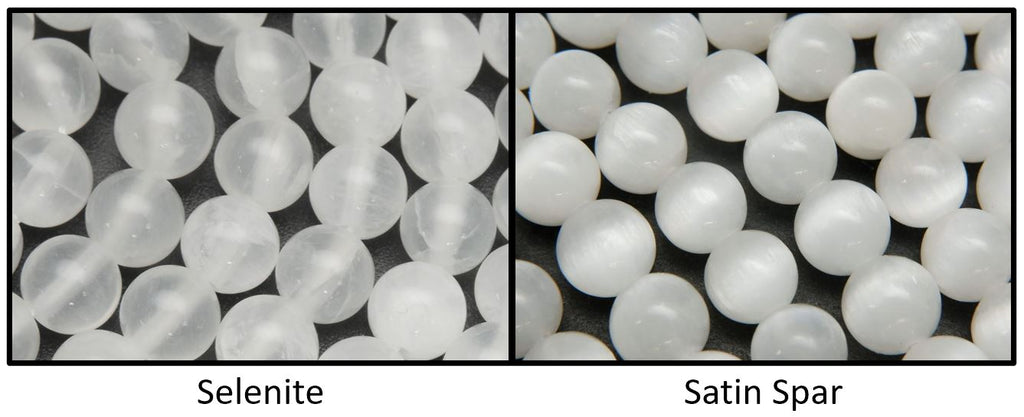Know Your Minerals: True Selenite vs Satin Spar

Selenite has become very popular due to its beautiful appearance and prominent metaphysical healing properties. Selenite, Satin Spar, and Desert Rose are all forms of the evaporite mineral gypsum. In this article we’ll discuss the characteristics of gypsum minerals, their formation, how to differentiate them, and how to spot the authentic ones from the fakes.
How Do Selenite and Satin Spar Form?
Selenite and Satin Spar are Gypsum minerals and are classified as Evaporites because they form when dissolved ions crystalize from evaporating bodies of water. An example would be in a shallow sea basin, lagoon, desert, hot spring, delta, or anywhere else that immobile water is evaporating without replenishment, resulting in high concentrations of ions that eventually crystalize into minerals either through precipitation or from all of the water evaporating leaving behind a thin layer of gypsum salt. Over millions of years, these thin salt layers can accumulate, building into thicker layers of gypsum. Over time these thin layers will turn into what are called beds and they will become buried resulting in compaction and exposure to high temperature where the beds undergo a process called lithification - where a stone is formed.
Evaporite forming environments can be found on almost every continent, making the selenite, satin spar and desert rose fairly common and abundant.
True Selenite vs Satin Spar - What is the difference?

Differentiating Satin Spar from Selenite it quite simple once you know what to look for. Selenite has a transparent appearance, sometimes with a white dull luster. Satin spar has a white fibrous appearance and a shine know at chatoyance – sometimes referred to as the cat’s-eye affect. Both minerals are very soft with a Mohs hardness of 2, meaning that they will scratch quite easily.
How to tell if satin spar and selenite are real?
As stated earlier, fakes are not common because of gypsums abundance, however every now and then you may find an imposter made of plastic of similar substance. If you suspect that you have a fake selenite mineral then you can test with the following steps.
- Scratch Test: Selenite and Satin Spar are very soft minerals and will scratch quite easily.
- Heat Test: Heat a pin or needle and touch it to the mineral - if it’s plastic it’ll melt.
- Dissolution Test: Selenite minerals will dissolve if left in water for extended periods of time.
- Perfection Test: While high grades of Selenite and Satin Spar can very pure, no natural stone is free of imperfection. Natural stones, even high-quality ones, will have the occasional inclusion or hairline crack.
Can Selenite and Satin Spar get wet?
Selenite and Satin Spar are both anhydrite minerals. All anhydrites will either dissolve or degrade with exposure to water. For this reason it's important to take off selenite jewelry prior to washing your hands in any situation where water contact is a risk. Angelite is another form of anhydrite that is important to keep dry.
A note about Selenite Desert Rose
Desert Rose is another form of selenite-like anhydrite and is formed in wet sand where calcium sulfate rich inflow is balanced by evaporation resulting in the perception of the excess calcium sulfate into a desert rose flower. This occurs in arid desert regions where the earth and air are dry with little rainwater to dilute the mineral concentrated groundwater. Desert rose, unlike the other gypsum mineral discussed in this article contain barite making them harder and more resistant to chemical erosion. Desert rose is easy to identify to its unique bladed rose shape.
Shop Selenite, Satin Spar, and Desert Rose Beads
If you have any experience with these minerals we'd love to hear about it! Share with the community by commenting below.

Comments on this post (1)
So the Evaporites (Gypsum, Selenite, Satin Spar and Angelite) are the “Don’t get it wet” category for special handling. The softness is an obvious consideration in jewelry design, as mentioned in the post about Mohs hardness. Doesn’t contact with sweat cause problems with jewelry/beads made from evaporites? Would Palm/Worry Stones being handled frequently easily get discolored?
— Elaine Billeter